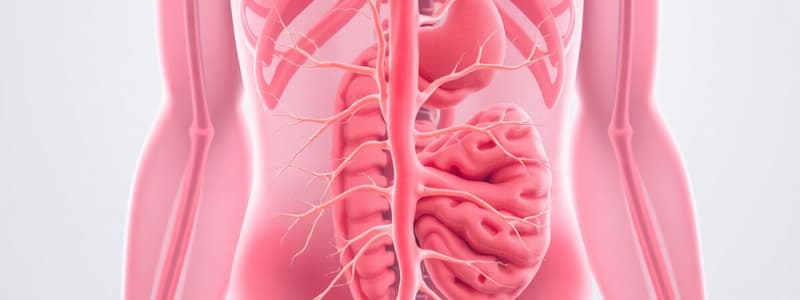Podcast
Questions and Answers
What is the primary neurotransmitter released by preganglionic neurons in the autonomic nervous system?
What is the primary neurotransmitter released by preganglionic neurons in the autonomic nervous system?
- Norepinephrine
- Acetylcholine (correct)
- GABA
- Epinephrine
Which division of the autonomic nervous system is primarily activated during times of stress or exercise?
Which division of the autonomic nervous system is primarily activated during times of stress or exercise?
- Central Nervous System
- Parasympathetic
- Somatic Nervous System
- Sympathetic (correct)
What type of receptors do postganglionic neurons use in the parasympathetic division?
What type of receptors do postganglionic neurons use in the parasympathetic division?
- Muscarinic acetylcholine receptors (correct)
- Beta adrenergic receptors
- Nicotinic acetylcholine receptors
- Alpha adrenergic receptors
During a state of relaxation, which division of the autonomic nervous system predominantly operates?
During a state of relaxation, which division of the autonomic nervous system predominantly operates?
How do beta adrenergic receptors primarily affect smooth muscle when activated?
How do beta adrenergic receptors primarily affect smooth muscle when activated?
What is the function of the adrenal medulla in the sympathetic nervous system?
What is the function of the adrenal medulla in the sympathetic nervous system?
What happens to heart rate when baroreceptors detect high blood pressure?
What happens to heart rate when baroreceptors detect high blood pressure?
Where are the preganglionic neurons of the parasympathetic division primarily located?
Where are the preganglionic neurons of the parasympathetic division primarily located?
Study Notes
Peripheral Nervous System Overview
- Autonomic Nervous System (ANS) is part of the Peripheral Nervous System (PNS) controlling involuntary visceral motor functions.
- ANS is divided into two systems:
- Sympathetic (Fight or Flight) is activated during stress and exercise.
- Parasympathetic (Rest and Digest) is activated during relaxation and digestion.
Balance Between Systems
- Both sympathetic and parasympathetic systems are continuously active, with their dominance shifting according to bodily needs.
- During rest, the parasympathetic system is predominant; during exercise, sympathetic activity increases.
Anatomy
- Preganglionic neurons, originating in the Central Nervous System (CNS), send signals to postganglionic neurons located in ganglia outside the CNS.
- Neurotransmitters are key:
- Preganglionic neurons always release acetylcholine (ACh).
- Postganglionic neurotransmitters differ:
- Sympathetic division predominantly uses norepinephrine.
- Parasympathetic division uses acetylcholine (ACh).
Sympathetic Division
- Preganglionic neurons are located in thoracic and lumbar regions, utilizing short fibers that synapse in sympathetic chain ganglia near the spinal cord.
- The adrenal medulla releases epinephrine (80%) and norepinephrine (20%) into the bloodstream, enhancing sympathetic responses.
Parasympathetic Division
- Preganglionic neurons originate in the brainstem (medulla, midbrain) or sacral regions with long fibers that synapse at or near target organs.
- The division features short postganglionic neurons.
Homeostasis and Reflexes
- ANS maintains homeostasis through reflex arcs.
- Example: High blood pressure activates baroreceptors, signaling the medulla to reduce heart rate via parasympathetic output, lowering blood pressure.
Neurotransmitter Receptors
- Parasympathetic receptors:
- Preganglionic neurons utilize nicotinic ACh receptors (ionotropic).
- Postganglionic neurons use muscarinic ACh receptors (metabotropic, G-protein coupled).
- Sympathetic receptors:
- Preganglionic neurons also have nicotinic ACh receptors.
- Postganglionic neurotransmitter norepinephrine binds to adrenergic receptors:
- Beta adrenergic receptors facilitate relaxation of smooth muscle and dilation.
- Alpha adrenergic receptors induce contraction of smooth muscle and constriction.
Adrenergic Receptors
- Beta receptors enhance cyclic AMP production, leading to smooth muscle relaxation.
- Alpha receptors activate phospholipase C pathway, increasing intracellular calcium levels, resulting in smooth muscle contraction.
Key Concepts for Pharmacy School
- Understand differing roles of sympathetic and parasympathetic divisions, including their anatomical and neurotransmitter distinctions.
- Recognize neurotransmitter receptors (Nicotinic, Muscarinic, Adrenergic) and their physiological implications.
- Grasp homeostatic regulation and reflex mechanisms involving the ANS.
- Comprehend the effects of adrenergic receptors: beta receptors cause relaxation while alpha receptors promote contraction.
- Acknowledge the adrenal medulla's role in sympathetic responses, as these foundational concepts are crucial for pharmacological applications related to the ANS.
Studying That Suits You
Use AI to generate personalized quizzes and flashcards to suit your learning preferences.
Description
Explore the key concepts of the Autonomic Nervous System (ANS), which is a vital component of the Peripheral Nervous System (PNS). This quiz covers its two main divisions: the sympathetic and parasympathetic systems, highlighting their roles in the body’s response to stress and relaxation. Test your knowledge on the balance between these systems and their significance in regulating involuntary functions.




